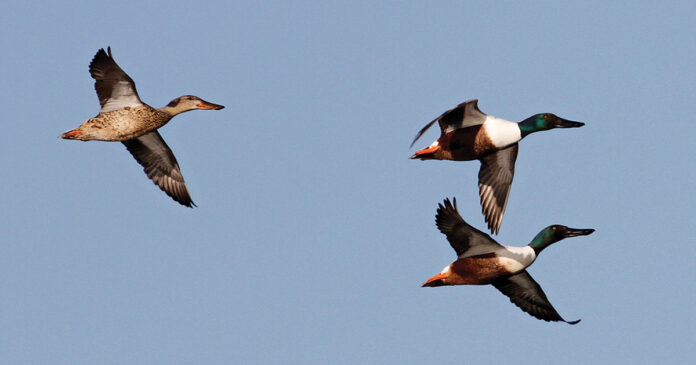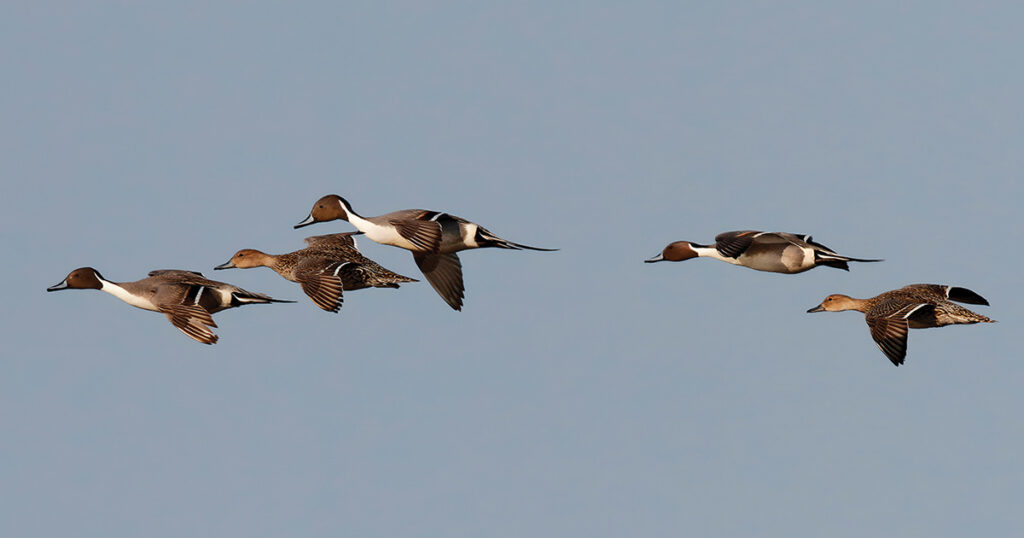
Ducks Unlimited dishes on the Pacific Flyway big picture, but most-recent SoCal report a slow one
BY PETER OTTESEN
IMPERIAL VALLEY – For the first autumn in many years, habitat conditions are good in most of California’s important waterfowl wintering and migration areas. This is excellent news for the highly anticipated migration of ducks, geese, swans, and associated species that are dependent on the state’s wetland habitats.
Water is plentiful and food production is high in the Grassland Ecological Area of western Merced County. The 240,000-acre complex is the largest contiguous wetland in the western United States, and ducks began to arrive there in early August, specifically northern pintails, green-winged teal, and shovelers.
“Water is the key element that has allowed for summer irrigation of seasonal wetlands to promote moist-soil plants. Ponds began to fill in early September to await the fall migration. Bird numbers are solid and building,” said habitat consultant Bob Nardi.
As a bonus, local mallard production is better than in 2023. Sean Allen, manager of the Los Banos Wildlife Area, says that locally reared birds, mostly mallards, cinnamon teal, and gadwalls, are up. His public areas are fully flooded, offering excellent habitat due to the availability of well-timed water.
“The migration comes early to locations such as Volta Wildlife Area and continues to build,” Allen says. “Bellwether species such as lesser sandhill cranes are already showing up in large groups, a good sign that birds are coming from the northern prairies.”
Among the ducks, Allen and Nardi agree that northern shovelers have arrived en masse. Shovelers are the second most numerous duck harvested in the Grasslands, next to green-winged teal. Northern pintails, which have a daily limit of one, will be very evident in hunters’ bags, especially in the early going.
Allen says the best prospects on public lands include Volta Wildlife Area and Salt Slough in the riparian areas, with ample northern pintails and green-winged teal. “The full allotment of water improved the wetlands habitat,” he says.
The Grasslands area of California comprises approximately 67 percent private land and 33 percent state and federal land in the heart of the Central Valley. With the abundance and quality of the wetlands here, it is not surprising that Merced County annually puts more ducks on hunters’ straps than any other county in the entire US.
In the rice country north of Sacramento, more than 400,000 acres (about half the area of Yosemite National Park), give or take, is under agricultural production, and the harvest is currently well underway. In fact, many of the harvested fields have already been flooded to decompose the rice straw and offer excellent habitat for ducks and geese. Given that 5 to 6 million ducks are expected to migrate into the Central Valley, and that 90 percent of the historic wetlands have vanished, the habitat provided by winter-flooded rice fields is an absolute linch pin for waterfowl survival.
At the Sacramento National Wildlife Refuge Complex, 90 minutes north of Sacramento, habitat conditions were excellent going into the spring and fall because of a full water allocation. “At this point we are well into our flood-up, which we will stagger up through mid-November,” says Michael D’Errico, supervisory biologist at the complex.
D’Errico adds that there are more white-fronted geese on the west side of the valley this year. “Of course, northern pintails are a phenomenal show,” he says. “One thing that stands out is a big push of wigeon, more than we normally see this early in fall. Overall, our bird numbers are right where we should be, based on historical data. In fact, we are a bit higher than average.”
The Suisun Marsh complex, just east of San Francisco Bay, is the largest estuary in the state. It is currently fully flooded and attracting a larger than normal number of birds, reports field scout Yancey Forest-Knowles. “Things looked very positive for the opener, no doubt,” he says. “Especially for wigeon, northern pintails, shovelers, and green-winged teal.”
The Sacramento-San Joaquin River Delta has limited early habitat because of late corn and rice harvest, but islands that have managed wetlands and riparian areas are loaded with ducks, primarily local birds such as mallards and wood ducks.

In the Klamath Basin, part of the Southern Oregon/Northeast California region known as SONEC, conditions are dry due to chronic water shortages. At Lower Klamath National Wildlife Refuge (NWR), where the season was supposed to open on October 5 to coincide with the Oregon waterfowl opener, there is no public hunting due to low water and a severe outbreak of avian botulism that has killed more than 100,000 birds. To put that death count into perspective, it represents about nine percent of all the ducks taken by hunters in California.
Hunting is allowed in some portions of neighboring Tule Lake NWR, but low hunter success reflects the paucity of birds in the basin.
A bright spot is Modoc NWR, which is typically among the finest hunting areas in the state. Hunters at Modoc averaged 6.4 birds on opening day. Spokesman Mike Hinton reports that the typical bag was composed of mallards, wigeon, gadwalls, and green-winged teal.
Modoc is open Tuesdays, Thursdays, and Saturdays, with no fees nor reservations required.
“We average about 60 hunters a day early on, dropping to about 40 hunters by mid-October and less than 20 by early November,” Hinton says. “By then the weather freezes and most birds move out, except for Canada geese.”
Flyway needs new ducks
By Jim Niemiec
NILAND – Duck hunting slowed down this past week as hunters bagged fewer ducks as compared to opening weekend. The bulk of waterfowl bagged were local ducks, a few newly arrived puddle ducks, but only a minimal number of divers. While Kern posted a respectable per gun average of 4.3 bids, Wister dropped to a 1.77 bird average and San Jacinto shot for just a 1.30 bird harvest per gun.
The snow goose season for Imperial Valley didn’t open until Nov.4, but there are very few white geese in the valley.
Wister Wildlife Refuge – A total of only 159 hunters showed up for the Saturday hunt and they combined to harvest 273 ducks. Top duck on the comp list was the cinnamon teal with 93 killed to go along with 75 green-winged teal. For additional information on the Wister Unit call the DFW on site office at (760) 359-0577.
Sonny Bono Salton Sea National Wildlife Refuge – No report filed this week. For more information on hunting this national refuge, which is managed by the Wister staff, call (760) 359-0577.
Finney-Ramer Unit – No report filed. Finney-Ramer is part of the Imperial Wildlife Area, located on the south end of the Salton Sea, is open to hunters 7 days a week under a self-registration and self-reporting system. For more details on this refuge, also managed by the Wister Unit call (760) 359-0577.
San Jacinto Wildlife Area – This refuge hosted 150 shooters on Saturday and they combined to harvest a total of 256 ducks for an overall 1.30 bird average. Top duck shot was the cinnamon teal with 80 harvested, but hunting for mallards and gadwall was pretty good with nearly 50 of each species harvested. Shoot days are Wednesday and Saturday and draw time is 3 A.M. For additional information call the wildlife office at (951) 928-0580.
Lake Perris – Hunts from a boat only take place EVERY OTHER Sunday throughout the season. Limited to just eight boats. For additional information contact lakeperrishunting.com.
Prado Basin – Over all pretty slow hunting this past week with a mix of small puddle ducks harvested. Raahauge’s Duck Club, 951-735-6981, offers public hunting on Wed. and Sunday afternoons with check in time at 1:00 PM.
Lake Henshaw (My Country Club) – Will not start hunting until either late November or early December. Waterfowl hunting reservations are a must. For additional information call (760) 782-3501.
San Diego City Reservoir – There were 52 hunters out in shore line blinds for the Saturday they hunt and the shot for less than a 2 bird per gun average. Top duck killed was the ruddy duck, with just fair numbers for mallards and ringneck ducks.
Kern National Wildlife Refuge – This refuge posted a respectable 4.3 bird average for the Saturday hunt. Top duck on the comp list was the shoveler with over 100 spoonies killed to go along with 85 cinnamon teal and 34 gadwall. Top hunting sites were hunt units 1A, AP1-4 and the ADA site. For additional information on hunting Kern call (661)725-2767 or for the hunter information hotline call (661) 725-6504, which is updated after each shoot day. A web site is also available to access hunt results and other information about this popular southern San Joaquin Valley hunting refuge.
Cibola/Lower Colorado River – No report filed this week. For information on booking a couple of days in a goose blind while staying in a South Ranch cabin call the Cibola Sportsman’s Club at (818) 383-9434 or log on to their web site cibolasportsmansclub.com. Contact the Cibola National Wildlife Refuge at (928) 857-3253 for shoot days and draw information on the Farm Fields and open hunting on the Island Unit.



